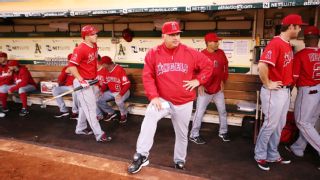|
Major League Baseball has implemented significant pace-of-play rule changes for the 2015 season in an effort to speed up the game, it was announced Friday. The rules include mandating that managers stay in the dugout during replay challenges, that hitters keep at least one foot in the batter's box during at-bats, a prompt return to play after TV commercial breaks and timed pitching changes.  "These changes represent a step forward in our efforts to streamline the pace of play," MLB commissioner Rob Manfred said in a statement. "The most fundamental starting point for improving the pace of the average game involves getting into and out of breaks seamlessly. In addition, the batter's box rule will help speed up a basic action of the game." The league, which announced the changes with the MLB Players Association, established a pace-of-game committee in September aimed at making recommendations to speed up games, which grew to a record average of 3 hours, 2 minutes in 2014, up from 2:33 in 1981. Players who violate the rules will receive a warning, with "flagrant violators" subject to a series of fines up to $500. The intention is not to impose penalties but rather to help change the habits of current players in an effort to speed up the game, sources told ESPN.com's Jayson Stark. The new rules begin in spring training, but the warnings and fines will not be imposed until May, as spring training and the first month of the regular season will be a phase-in period. Speed-up rules in the major leagues required the OK of the players' union, and baseball officials had said a pitch clock was ruled out for this season. However, sources told Stark that Major League Baseball will begin to compile data and inform all pitchers how long they take between pitches. Several new mandates, including the batter's box rule, were tried out during the Arizona Fall League in October and November. The batter's box rule remains in place unless an established exception occurs. Those exceptions include swinging at a pitch, foul balls, foul tips, if the hitter is brushed back by a pitch, time granted by the umpire and wild pitches. Also, two timers -- on or near the scoreboard and another on the facade behind home plate near the press box -- will be used in every major league ballpark to help quicken the pace. For each half-inning break, teams will have either 2 minutes, 25 seconds (for local telecasts) or 2 minutes, 45 seconds (national telecasts) from the time the commercial break begins until the first pitch should be thrown to the next batter, who should be in the batter's box with no fewer than 20 seconds remaining on that timer. If a pitcher fails to complete the traditional eight warm-up pitches before the timer reaches 30 seconds, he forfeits the right to do so. Pitching changes will also be timed like between-inning breaks. "The players believe that enforcing the rules that currently exist regarding between inning breaks and plate appearances is the best way to address the issue of pace of play," MLBPA executive director Tony Clark said in a statement. "We're confident that today's announcements will have a positive impact on the pace of the game without jeopardizing the integrity of the competition." San Diego Padres manager Bud Black said he hopes the changes will help lead to a brisker pace without altering baseball's competitive dynamic. "I think it's a good thing that we're exploring certain ways to speed up a little bit of the dead time,'' Black said Friday from Padres camp. "There's dead time all the way throughout a game -- in between innings, in between pitches, and when guys are taking their at-bats. There's some time that can be crunched a little bit to help the pace. "But I think we're all conscious of the way the game flows -- especially late in the game, when decisions might be at the highest for a manager or a pitcher-catcher combination. You don't want to let the pace of play interfere with conversations between a pitcher and a catcher, or from a pitching coach talking about strategy. Those are the things I think we worry about when you talk about pace of play.'' The new replay rules intend to reduce the time managers spend chatting with umps while awaiting recommendations from video coordinators or their own coaches. Among the changes, managers now can review whether a runner left a base early or properly touched a base. However, managers must now use a challenge for a review of the collision rule, which was decided by umpires in 2014. Managers are encouraged to request a replay -- either verbally or with a hand signal -- from the dugout instead of walking out on the field to challenge a call. This should take place within 20 to 30 seconds of the original call being made, sources told Stark. Managers, who used to retain their challenges after the first overturned call, now will retain their challenges after every call that is overturned. In addition, they will get a new second challenge to use during during regular-season tiebreaker games, the All-Star Game and postseason games. "The Pace of Game Committee wants to take measured steps as we address this industry goal to quicken the pace of our great game," said Atlanta Braves president John Schuerholz, who was the chairman of the Pace of Game and Replay Committee. "It is not an objective of ours to achieve a dramatic time reduction right away; it is more important to develop a culture of better habits and a structure with more exact timings for non-game action." Jayson Stark and Jerry Crasnick of ESPN.com and The Associated Press contributed to this report.
|

